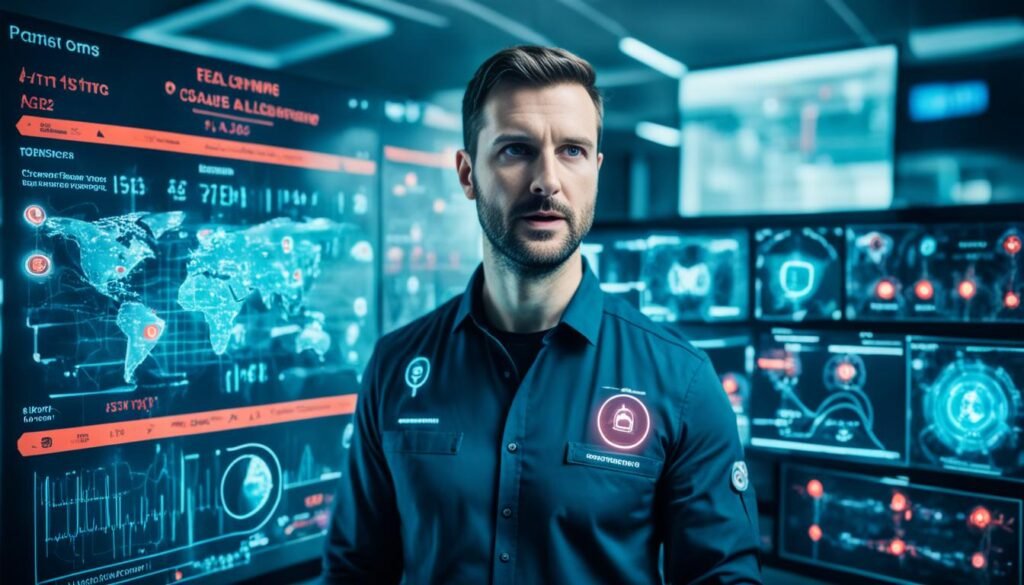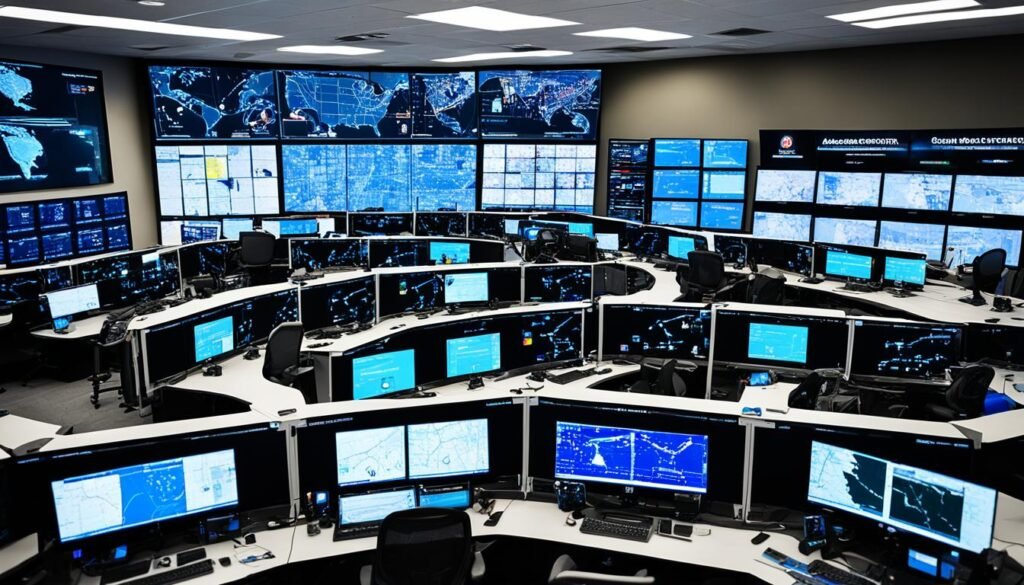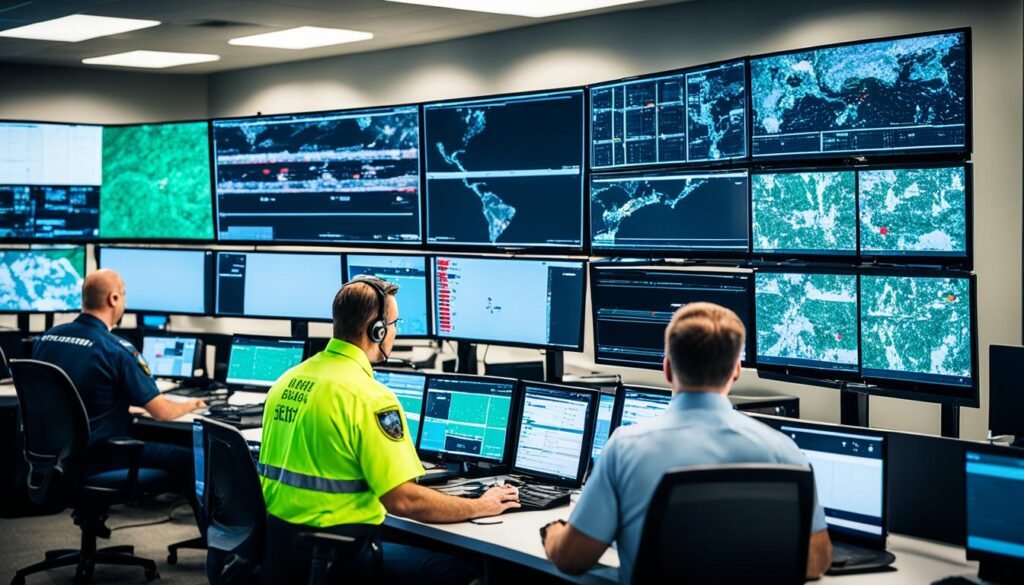Between 2019 and 2022, 1 in 4 jobs at 911 centers were left empty. This shows a big 25% shortage in emergency call center staff. This crisis, along with the growing need for quick and effective emergency help, has made the industry look for new solutions. Artificial intelligence (AI) is now seen as a big change-maker.
Even though AI is still new in 911 call centers, with only a few places in the U.S. using it, its benefits are clear. In South Carolina, Charleston County’s center saw a 36% drop in non-emergency calls after adding an AI system. This shows how AI can make handling non-emergency calls more efficient. It lets human dispatchers focus on real emergencies.
The 911 industry faces old infrastructure, not enough staff, and the need for better operations. The idea of AI solutions is getting more attention. Now, the big question is: Can AI replace human 911 dispatchers? Or will it be a big help in the future of emergency response?
Key Takeaways
- Between 2019 and 2022, 1 in 4 911 center jobs were vacant, indicating a 25% staffing shortage.
- Fewer than a dozen localities in the U.S. are currently using or testing AI in their 911 centers, showcasing a slow adoption rate.
- Charleston County, South Carolina, has reduced non-emergency call volume by 36% using an AI-powered system.
- AI could help dispatchers by enhancing audio quality, triaging calls, and providing language translation services.
- Implementing AI in 911 centers requires addressing data privacy and security concerns to ensure accuracy and fairness.
AI’s Transformative Role in 911 Call Centers
AI technology is changing how 911 call centers work. They face challenges like not having enough staff and dispatchers’ mental health. AI is helping by automating non-emergency calls and making better dispatch decisions.
AI Triage for Non-Emergency Calls
AI is making 911 work better by sorting calls. It looks at each call and sends non-emergency ones to the right places. This lets urgent calls get help faster. South Carolina’s 911 center uses AI for this, making things run smoother.
Addressing Staffing Shortages and Mental Health Challenges
AI is helping with the lack of staff in 911 centers. A report found 1 in 4 jobs were empty from 2019 to 2022. AI tools like the Prepared AI platform help by quickly understanding and sorting calls. They also make training better for emergency workers, helping with their mental health.

“AI algorithms can predict where and when emergencies are likely to occur by analyzing historical data and identifying patterns, enabling emergency services to allocate resources strategically.”
AI is making a big difference in 911 call centers. It helps with non-emergency calls, staff shortages, and mental health. This makes communities safer and healthier across the country.
The Current Landscape of AI in Emergency Dispatch
AI is still new in emergency dispatch services, but some states in the U.S. are starting to use it. Only a few places in seven states are testing AI to make their 911 centers better and speed up emergency responses.
Early Adoption Across States
States like Colorado, Connecticut, and Texas are leading the way with AI in emergency dispatch. They want to use AI to make calls easier to handle, speed up responses, and give more accurate help. AI looks at call patterns to help 911 operators quickly sort and prioritize emergencies.
Opportunities and Challenges
Using AI in emergency dispatch has both good and bad sides. AI can make things faster and help with language barriers, making sure people get help quickly. But, there are worries about AI being biased and making unfair decisions.
There are also concerns about how AI will make decisions in emergencies. This shows we need a careful approach. AI should work with human 911 operators to make sure everyone gets the help they need.
Concerns About Bias and Liability
As AI becomes more common in emergency dispatch, agencies are being careful. They worry about AI being biased, which could mean some get less help in emergencies. There’s also the issue of who is responsible if AI makes a mistake.
To fix these problems, we need more research and testing. It’s important for tech companies, safety agencies, and the community to work together. This will help shape the future of AI in emergency services.

Boosting Efficiency and Reducing Workload
Public safety agencies are facing big challenges with staffing and more calls. AI solutions are now seen as a way to make things run smoother and ease the load on 911 dispatchers. Already, AI systems for call-taking in 911 centers are being tested or used in places like Colorado, Maryland, Missouri, Oregon, South Carolina, Texas, and Virginia.
Call center workers often deal with both urgent and non-urgent calls. With fewer people available, some governments are looking at AI for public safety to help. This could reduce the workload on human dispatchers.
Places like the Arlington County Emergency Communications Center in Virginia, the St. Louis County Police Department in Missouri, and the Jefferson County Communications Center Authority in Colorado are using new tech. They’re using systems like Amazon Connect to handle non-emergency calls. This lets 911 call triage and automated 911 dispatch teams focus on real emergencies. This makes things more efficient and quick to respond.
The Vesta software is a big part of 65 percent of 911 calls in the U.S. Its Vesta NXT platform can cut a call handler’s workload by up to 35 percent. This tech gives important info to AI-powered emergency response. It’s great for both big and small public safety groups.
| Feature | Benefit |
|---|---|
| Vesta NXT call handling | Up to 35% reduction in call handler workload |
| Contextual information for call handlers | Improved decision-making and response times |
| Suitable for agencies of all sizes | Scalable and adaptable to diverse needs |
As AI in emergency services grows, public safety groups are looking at different ways to pay for and use tech from companies like Motorola. This will help them make the most of these new intelligent 911 systems.

Technological Limitations and Funding Needs
Artificial intelligence systems could change emergency services a lot. But, they face big challenges. Many call centers use old technology that can’t keep up with new changes. Even with everyone having cellphones, some systems still can’t find where a call is coming from easily.
Funding for safety technology often gets overlooked. People don’t think they’ll need to call 911, so it’s not a priority.
Outdated Infrastructure and Funding Gaps
AI in emergency services is promising, but many centers need basic tech upgrades first. Over 50% of companies use AI in some way, mostly in making products or improving services. But, public safety is behind, with only a few places using AI in 911 centers.
Funding is a big issue too. Most states haven’t fully funded a 988 service for mental health crises. This shows how hard it is to get resources for safety projects. 911 centers use old technology from the 1930s. Agencies are slow to use AI because they worry about it causing problems, adding to the funding and tech challenges.
“The infrastructure of 911 centers remains outdated with technology from the 1930s.”
Despite the problems, AI in emergency services could be a big win. AI can learn about cities and predict emergency needs, making responses better. It could also help save more lives by spotting cardiac arrests sooner.
The safety sector is facing staff shortages and needs better, tech-based solutions. Upgrading infrastructure and funding AI for emergencies is key. The future of emergency services depends on using technology wisely and solving the issues of funding and old systems.
will ai replace 911 dispatchers
AI is changing many industries, making people wonder if it will replace 911 dispatchers. But, experts in emergency services say AI will not replace them. Instead, it will help them work better and make their jobs easier.
A study shows that 911 dispatchers have a 49% chance of automation. This means they are not likely to be fully replaced by AI soon. They are ranked #298 out of #702, showing they are not at high risk of being automated. In the U.S., 911 dispatchers earn a mean annual wage of $41,070 and a mean hourly wage of $19.
“I cannot stress enough that it does not take away jobs, especially in the 911 industry. It’s there to help them enhance their job,” said Jacob Saur, the emergency communications center administrator for Arlington County Public Safety Communications and Emergency Management.
Arlington County was one of the first to use AI in 911 call centers. They use Amazon Connect to handle non-emergency calls. This AI system can manage reports on storm damage, graffiti, towing, and help with police reports. This lets dispatchers focus on real emergencies.
AI is seen as a big help for emergency systems that are short on staff. But, Brian Fontes, CEO of the National Emergency Number Association, thinks AI will give public safety leaders better data. He doesn’t think it will replace 911 dispatchers anytime soon.

| Metric | Value |
|---|---|
| Chance of Automation for 911 Dispatchers | 49% |
| Rank of 911 Dispatcher Job | #298 out of #702 |
| Mean Annual Wage for 911 Dispatchers | $41,070.00 |
| Mean Hourly Wage for 911 Dispatchers | $19.00 |
| Number of 911 Dispatchers Employed in the U.S. | 95,170 |
AI-Powered Emergency Response: Industry Partnerships
AI in emergency services is growing fast, with leaders forming key partnerships to improve 911 call centers. Apple’s iOS 18, coming out this fall, will bring a new feature called Emergency SOS Live Video. This feature, with help from Prepared technology, lets 911 dispatchers see what iPhone users see during emergencies live.
Apple’s iPhone is used by over 59% of U.S. smartphone users. So, this feature could help 125 million people in the U.S. use live video for emergency calls and responses.
RapidSOS is also making big moves in 911 technology. They’re working with Google to bring Rich Communication Services (RCS) to 911 centers this winter. This will make texts, videos, and multimedia files more important in 911 calls. It will help send out critical info faster during emergencies.
| Technology | Description | Benefits |
|---|---|---|
| Apple’s Emergency SOS Live Video | Enables 911 dispatchers to see what iPhone users see in real time during emergencies | Provides critical visual information to aid in emergency response, potentially benefiting over 125 million people in the U.S. |
| RapidSOS Rich Communication Services (RCS) | Enhances 911 operations by integrating text, video, and multimedia capabilities | Improves the flow of critical information during emergency situations |
These partnerships show how ai in emergency services, ai dispatching, and 911 call automation are making emergency responses better. As ai for public safety and automated 911 dispatch grow, the future of ai-powered emergency response looks set to get more efficient and effective.
AI in Action: Nashville’s Prepared Assist Platform
The role of AI in emergency services, AI dispatching, and 911 call automation is becoming more clear thanks to Prepared. This 911 livestreaming and AI company has launched Prepared Assist. It’s a cloud-based 911 platform used by the Metro Nashville Department of Emergency Communications. This shows how emergency response AI and AI-powered emergency response systems work in real life.
The Prepared Assist platform makes critical operations smoother. It offers real-time monitoring, quicker emergency location finding, keyword alerts, and AI-backed audio transcriptions. Prepared’s CEO, Michael Chime, says the platform has made a big difference in Nashville. It helps with training new staff and handles calls in languages other than English with intelligent 911 systems and AI for public safety.
“The Prepared Assist platform has been a game-changer for our 911 call center, enhancing our ability to respond quickly and effectively to emergencies.”
– Spokesperson, Metro Nashville Department of Emergency Communications
Using Prepared Assist in Nashville shows how AI in emergency services and automated 911 dispatch can change things for the better. This platform uses advanced tech to make the city’s emergency communication systems more efficient and quick. This means the community gets safer and better care during emergencies.
The Future of AI in Emergency Services
Artificial intelligence (AI) is changing how we handle emergencies. It can make 911 call centers work better and speed up responses. But, adding AI to emergency services brings new challenges that need to be solved for safety and reliability.
Potential Advancements and Challenges Ahead
AI can help manage a lot of calls at once and ease the workload of dispatchers. It can sort out non-emergency calls, so people can focus on urgent ones. Also, AI can quickly understand and respond to threats by transcribing audio and spotting key words.
But, there are worries about bias, legal issues, and losing human jobs. It’s important to make sure AI is used right to keep people’s trust and protect everyone’s safety. We also need to update old systems and get enough money to use AI in emergencies fully.
- U.S. private industry invested nearly $50 billion in AI in 2022 alone.
- AI showed it can find breast cancer that doctors missed.
- Jefferson County, MO (St. Louis) saw a 40% decrease in non-emergency calls at the emergency center after using AI.
As AI gets better, we need to think carefully about how we use it in emergency services. We must balance the good things it can do with the ethical and practical issues it raises. This will help shape the future of AI in emergency services.
“AI can be a force multiplier due to ongoing staffing shortages at 911 call centers,” suggests Brian Fontes, CEO of the National Emergency Number Association.
The impact of AI on emergency services is still unfolding. But, one thing is sure: AI will keep being a key topic for new ideas and talks in the future.
Conclusion
AI in emergency services has big potential but faces many challenges. AI-powered 911 dispatching can manage calls better, lighten workloads, and boost efficiency. Yet, the tech is still new, and worries about bias, liability, and job loss are real.
As AI for public safety gets better, finding the right mix of automation and human oversight is key. This ensures emergency response stays quick, effective, and fair for everyone. It’s important to protect data, be open, and fix biases in these intelligent 911 systems.
The future of 911 call automation and emergency response AI looks bright. But, it will take teamwork from policymakers, tech makers, and emergency teams to beat the tech limits and funding issues holding it back. By tackling these hurdles, your community can use AI-powered emergency response to make public safety better and save lives.
FAQ
How is AI transforming 911 call centers?
AI is now helping sort and manage non-emergency calls. This lets human dispatchers focus on real emergencies. It’s tackling the big issues of not enough staff and mental health in emergency services.
What are the concerns about using AI in 911 call centers?
People worry about AI being biased, making wrong decisions, and overusing police. There’s also fear it could take away dispatcher jobs.
Where is AI being tested or implemented in 911 call centers?
AI is being tested or used in 911 centers in Colorado, Maryland, Missouri, Oregon, South Carolina, Texas, and Virginia.
How is AI helping to boost efficiency and reduce dispatcher workloads?
AI systems manage non-emergency calls, so dispatchers can focus on emergencies. This makes their work easier and improves how well things run.
What are the technological limitations and funding challenges facing 911 call centers?
Many 911 centers have old technology and can’t keep up with new tech fast enough. Getting enough money for updates is a big problem for them.
Will AI completely replace 911 dispatchers?
No, AI won’t replace human dispatchers. It’s meant to help them by doing non-emergency tasks. This lets them focus on urgent calls.
How are industry partnerships driving advancements in AI-powered emergency response?
Partnerships with companies like Apple and RapidSOS are adding new features to 911 centers. These features help them respond better to emergencies.
Can you provide an example of how AI is being used in a 911 call center?
The Metro Nashville Department of Emergency Communications uses the Prepared Assist platform. It has AI for real-time checks, finding emergency locations faster, alerting with keywords, and AI-transcribing audio.
